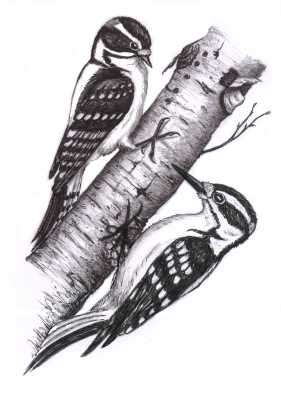
Dear Bird Folks,
I have a wonderful black and white woodpecker coming to my suet feeder. My bird book shows two different woodpeckers that both look like my woodpecker. One is called a downy woodpecker and the other is a hairy woodpecker. How can I tell which one is in my yard?
– Terry Osterville
First of all, Terry,
Despite what you have heard, size does matter. The hairy woodpecker is much larger than the little downy. However, unless you see them together, the size reference isn’t all that obvious. If it was easy, then you wouldn’t have had to write your note and I could be eating a dish of ice cream instead of writing this column.
When they aren’t together, identifying a downy from a hairy woodpecker is like trying to recognize a politician from a regular crook. You need a few clues. A good field mark is the bill length. On a downy, the bill is about half the size of its head, whereas on a hairy the bill is as large or larger than the head. So if a woodpecker’s head is an inch long, then a downy’s bill would be about a half inch long and a hairy’s bill would be at least an inch long. Bill length is important since we don’t often see both the hairy and downy traveling together. Yet, rarely does a woodpecker go anywhere without bringing both its own bill and head with it.
One other important field mark is that the outside edge of a hairy’s tail is totally white, but the outer edge of a downy’s tail is white with a few black spots. For either bird the sexes are alike, except that the males have a bright red spot on the back of their heads. Sometimes the females have bright red lipstick, but those birds are usually from the city.
Here is something worth knowing. The names “hairy” and “downy” refer to the clump of feathers at the base of each bird’s bill. Many woodpeckers have a bushy growth of feathers at the base of their bill. This fluff is much like those silly goatees that pseudo macho men grow on their faces. The woodpecker’s feathery goatee is not there to look tough or trendy, but to protect its nostrils from wood chips and dust. When a woodpecker digs out a cavity in a tree, small bits of wood can clog up its nostrils, which are located at the base of its beak. The little bush of feathers is very helpful at keeping out the bits of wood, but it can get awfully messy during the cold and flu season.
Good luck with your woodpecker, Terry. I hope you can figure it out. As for me, I’ll be headed for a government safe house trying to hide from any big guy with a goatee.